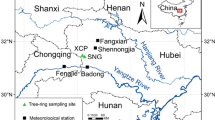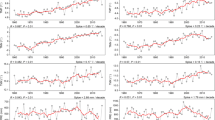Abstract
We reconstructed April mean temperatures in Kyoto since the fifteenth century by investigating historical documents such as diaries and chronicles and compiling phenological data series of the full bloom date for herbaceous peony. In order to fill gaps in phenological data series, we used the full bloom date of rabbit-ear iris, an herbaceous plant that flowers at about the same time of the year as an herbaceous peony. We obtained floral phenological data covering a total of 278 years. Calibration using modern temperature data showed herbaceous peony phenology to be the preferred data source for April temperature estimation. Variations in the reconstructed April temperatures in Kyoto were synchronous with changes in the solar cycle. In particular, April temperatures were about 2 ℃ lower than at present around the ends of the Spoerer and Maunder grand solar minima, from 1550 to 1590 and from 1690 to 1730, respectively. In addition, the reconstructed April temperatures suggested a time lag in the climate response to solar activity changes that was about 10 years longer than the previously estimated lags in the responses of wintertime and March temperatures. However, further research is needed to accurately quantify this time lag.









Similar content being viewed by others
References
Ahas R (1999) Long-term phyto-, ornitho- and ichthyophenological time series analysis in Estonia. Int J Biometeorol 42:119–123
Aono Y (2012) Long-term change in climate and floral phenophase. Chikyu Kankyo (glob Environ) 17:21–29 ((in Japanese))
Aono Y (2015) Cherry blossom phenological data since the seventeenth century for Edo (Tokyo), Japan, and their application to estimation of March temperature. Int J Biometeorol 59:427–434
Aono Y, Kazui K (2008) Phenological data series of cherry tree flowering in Kyoto, Japan, and its application to reconstruction of spring time temperature since the 9th century. Int J Climatol 28:905–914
Aono Y, Saito S (2010) Clarifying springtime temperature reconstructions of the medieval period by gap-filling the cherry blossom phenological data series at Kyoto, Japan. Int J Biometeorol 54:211–219
Aono Y, Tani A (2014) Autumn temperature deduced from historical records of autumn tint phenology of maple tree in Kyoto, Japan. Clim in Biosph 14:18–28 ((in Japanese))
Ault TR, Schwartz MD, Zurita-Milla R, Weltzin JF, Betancourt JL (2015) Trends and natural variability of spring onset in the coterminous United States as evaluated by a new gridded dataset of spring indices. J Clim 28:8363–8378
Bradley RS ed. (2015) Paleoclimatology: reconstructing climates of the quaternary, 3rd ed., Academic Press, Oxford
Chuine I, Yiou P, Viony N, Seguin B, Daux V, Le Roy LE (2004) Grape ripening as a past climate indicator. Nature 432:289–290
Defila C, Clot B (2001) Phytophenological trend in Switzerland. Int J Biometeorol 45:203–207
Garnier E, Daux V, Yiou P, de Cortázar-Atauri IG (2011) Grapevine harvest dates in Besançon (France) between 1525 and 1847: social outcomes or climatic evidence? Clim Chang 104:703–727
Ge Q, Wang H, Zheng J, This R, Dai J (2014) A 170-year spring phenology index of plants in eastern China. J Geophy Res (biogeosci) 119:301–311
Gray LJ, Scaife AA, Mitchell DM, Osprey S, Ineson S, Hardiman S, Butchart N, Knight J, Sutton R, Kodera K (2013) A lagged response to the 11 year solar cycle in observed winter Atlantic/European weather patterns. J Geophys Res Atmosph 118:13405–13420
Ichihashi S, Shimizu R, Hirabayashi M (2009) Studies on the growth condition endemic endangered plant Iris laevigata. Bull Aichi Univ Educ (nat Sci) 58:43–50 ((in Japanese))
Kiss A, Eilson R, Bariska I (2011) An experimental 392-year documentary-based multi-proxy (vine and grain) reconstruction of May–July temperatures for Kőszeg, West-Hungary. Int J Biometeorol 55:595–611
Kodera K (2006) The role of dynamics in solar forcing. Space Sci Rev 125:319–330
Kodera K, Kuroda Y (2002) Dynamical response to the solar cycle. J Geophys Res 107:4749
Liu Y, Fang X (2017) Reconstruction of spring phenology and temperature in Beijing, China, from A.D. 1741 to 1832. Int J Climatol 37:5080–5088
Možný M, Brázdil R, Dobrovolný P, Trnka M (2012) Cereal harvest dates in the Czech Republic between 1501 and 2008 as a proxy for March–June temperature reconstruction. Clim Chang 110:801–821
Omoto Y, Aono Y (1990/91) Effect of urban warming on blooming of Prunus yedoensis. Ener Build 15–16:205–212
Omoto Y, Hamotani K (1979) A proposed method of eliminating urban effects from climatological data obtained at stations in big cities. J Agric Meteorol 35:93–96 ((in Japanese))
Shindell DT, Schmidt GA, Mann ME, Rind D, Waple A (2001) Solar forcing of regional climate change during the Maunder minimum. Science 294:2149–2152
Solanki SK, Usoskin IG, Kromer B, Schussler M, Beer I (2004) Unusual activity of the Sun during recent decades compared to the previous 11,000 years. Nature 431:1084–1087
Sparks TH, Carey PD (1995) The responses of species to climate over two centuries. An analysis of the Marsham phenological record, 1736–1947. J Ecol 83:321–329
Tagami Y (2016) Reconstruction of climate variation of Japan from 11th to 16th century. Mem Fac Hum Develop Univ Toyama 10:205–219 ((in Japanese))
Van der Linden RAM, the SIDC team, Outline catalogue of the sunspot index, http://sidc.oma.be/html/sunspot.html [last accessed in Dec. 2020]
Wang X, Zhang QB (2011) Evidence of solar signals in tree rings of Smith fir from Sygera Mountain in southern Tibet. J Atmos Solar-Terrest Physic 73:1959–1966
Wang H, Dai J, Zheng J, Ge Q (2014) Temperature sensitivity of plant phenology in temperate and subtropical regions of China from 1850 to 2009. Int J Climatol 35:913–922
Waple AM, Mann ME, Bradley RS (2002) Long-term patterns of solar irradiance forcing in model experiments and proxy based surface temperature reconstructions. Clim Dyn 18:563–578
Author information
Authors and Affiliations
Corresponding author
Rights and permissions
About this article
Cite this article
Aono, Y., Nishitani, A. Reconstruction of April temperatures in Kyoto, Japan, since the fifteenth century using the floral phenology of herbaceous peony and rabbit-ear iris. Int J Biometeorol 66, 883–893 (2022). https://doi.org/10.1007/s00484-022-02245-x
Received:
Revised:
Accepted:
Published:
Issue Date:
DOI: https://doi.org/10.1007/s00484-022-02245-x




